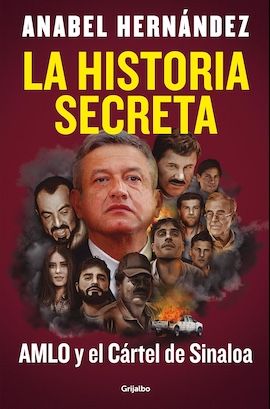SWJ-El Centro Book Review – La Historia Secreta: AMLO y el Cártel de Sinaloa

Anabel Hernández, La Historia Secreta: AMLO y el Cártel de Sinaloa. Miami: Grijalbo (Penguin Random House), 2024. [ISBN: 979-88-909818-2-0, Hardcover, 352 pages]
“¡Plebada! ¡Puro Morena! ¡Puro AMLO!”[1] were the words echoed through the radio frequency of the Cártel de Sinaloa (CDS) on 1June 2018, when Andrés Manuel López Obrador (AMLO) celebrated his victory at the Zocalo in Ciudad de México (p.138). Through her writing, journalist Anabel Hernández depicts the people ofMexico’s enthusiasm towards the dethroning of the Partido Revolucionario Institucional (PRI) party andexpected arrival of change. What they did not expect was that the change would be a trojan horse from the CDS, whose contributions allowed them to become the number one drug trafficking organization in both Mexico and the world at the time (p.161). Across the border, millions of m30 pills (fentanyl) began to flood the United States and result in the highly impacted Kensington borough in Pennsylvania to become known as “Zombieland.”
In La Historia Secreta: AMLO y el Cártel de Sinaloa, Hernández effectively engages readers through direct evidence obtained via various CDS members who narrate notable events for the illicit organization. Notable interviewees include: Dámaso “El Mini Lic” López Serrano, an unnamed head of security for Edgar “La Barbie” Valdez Villareal, Guillermo “El Lagartijo” Michel Hernández, a notable CDS gunman, retired California Department of Justice (CALDOJ) special agent Steve Duncan among other credible unnamed sources.Hernández’s writing allows readers to feel as if they are in the same room as interviewees and witnesses in the narrated events.
Hernández structures Chapters 1–4, by creating a reverse cause and effect relationship with the titles. Hernández titles Chapter 1, “Zombieland” as an allusion to Kensington, a neighborhood in Philadelphia.Kensington is home to many “zombies,” a nickname used to refer to fentanyl users who behave as if they are in limbo. Chapter 2 is titled “Génesis” to refer to the rise of CDS through an interview with El Mini Lic, where he explains the origins of all their feats: their mixing of fentanyl with their product, the relationship of his father, Dámaso “El Licenciado” López, with Joaquín “El Chapo” Guzmán Loera, Iván Archivaldo Guzmán Salazar’s ruthlessness, and the animosity between the CDS factions of Ismael “Mayo” Zambada García and El Chapo. The title of Chapter 3, “Los Chapitos” refers to the nickname used to reference all of El Chapo’s sons. This chapter details Los Chapitos through the eyes of El Mini Lic: their relationships with one another, who hebelieves to be the most violent, and Edgar Guzmán López’s death. Additionally, he describes how two figures now in the public eye, Margarito and Pedro Flores, began to associate with CDS. Chapter 4, “Comó se Fraguó la Pandemia del Fentanilo” involves El Mini Lic’s perspective on the origins of fentanyl and how Los Chapitos were the first to exploit this drug, in addition to the division of territory between Los Chapitos and the “Dámasos” faction, led by El Licenciado and his son after El Chapo’s arrest.
Chapters 5––8 analyze how CDS supported AMLO during his 2006 presidential run, and specifically what it took to fall just short of obtaining victory. Chapter 5, “¡Plebada, puro Morena! “¡Puro AMLO!” details the war between the Dámasos and Chapitos in addition to mentioning Javier Valdez, a journalist and friend of the author. Hernández displays vulnerability when illustrating the risk journalists like herself and Valdez put themselves through to carry out their important work. Hernández emotionally writes about Valdez’s assassination by CDS members to prevent the leaking of important CDS ties with the Mexican government (p.130). In Chapter 6, “Caballo de Troya” Hernández identifies AMLO as a Trojan Horse for CDS, because of his failure to bring the change the people of Mexico expected. This chapter also introduces the origins of the ties between AMLO and CDS. In Chapter 7, “Operación Polanco,” Hernández discusses her interview with Mauricio “Mau” Soto Caballero, an individual who played a key role in AMLO’s many presidential campaigns. Mau details AMLO’s children, his role in obtaining the CDS bribes intended for AMLO. Hernández also includes a scandal that depicts AMLO as a “prestidigitador” (p.171), meaning a prestidigitator, indicating an ability to make things disappear as if to cover one’s tracks.[2] Chapter 8, “Narcopresidente” includes all the ways CDS contributed to AMLO’s campaign including funding, event logistics, etc. The rise of suspicion towards the funding of AMLO’s campaign is also detailed.
Chapters 9-12 explore the aftermath of CDS after AMLO’s loss in Mexico’s 2006 presidential race. Chapter 9, “Una Inversión Reditubale,” details the reaction of CDS to AMLO’s loss, the arrest of La Barbie, Sergio “El Grande” Villareal Barragán, and the turning of CDS member Roberto López Najera “El Diecinueve” and El Grande. Chapter 10, “Al Descubierto” details a New York task force looking into the illicit financing of AMLO’scampaign, and the role of Mau and Nicolás Mollinedo Bastar, “Nico” to disprove this. Chapter 11, “Y También El Cártel de Tijuana” (CDT) introduces CDT’s contributions to AMLO’s 2006 campaign through an interview of Steve Duncan with information obtained from Francisco Javier Arellano Félix “El Tigrillo.” Chapter 12, “El Reino” details the Chapitos introduction of m30 pills (fentanyl) to other traffickers within their network and explains the massive profit margin in addition to an intro narration of the first “Culiacanazo” through the eyes of El Lagartijo.
Chapter 13-15 review the end of the AMLO presidency. Chapter 13, “La Embajadora del Cártel de Sinaloa,” continues narration of the first Culiacanazo by El Lagartijo, in addition to introducing the role of Ana Karen Val Medina, who was the mayor of Elota, a municipality of which her sentimental partner known as “El 00” had control of (p.283). Chapter 14, “Viejo Diablo” covers El Mayo Zambada and details his health conditions, inaddition to his public relations ability which earned him his distinguished power of connections with the Mexican government. Chapter 15, “La Heredera” introduces Jose Ángel Zazueta Rivera “El Flaco,” an individual of high ranking within Los Mayitos, and his discontent with Sheinbaum’s actions during her Jefa De Gobierno, or Governor, of Ciudad de Mexico tenure as she would seize half of any desired trafficking substance in exchange for allowing products to be trafficked (p.323).[3] The controversial Secretary of Citizen Security and Civilian Protection Omar García Harfuch’s tactics are mentioned through El Mini Lic’s perspective. Hernández also identified Sheinbaum as the ideal presidential candidate for both CDS factions to win the 2024 elections (p.340).
The general public will also benefit from reading Hernández’s work to obtain an understanding of the origins of the rivalry between the Chapitos and Mayitos factions, the influence of cartels on politics, among otherconcepts. Overall, Hernández does a fantastic job at keeping readers engaged with the descriptions she provides from her interviewees’ personal accounts while also explicitly cross-referencing the information the interviewees provide her with what she has obtained from other interviews. Hernández’ work across her many books and articles have successfully been able to tell the story of many cartels and their disputes through the eyes of former and current members. It is important to understand the internal dynamics of Mexico’s drug cartels, as these will help the public understand how these organizations function: what causes disputes, unity, and the mindset of the operators of these entities. The empirical contribution of journalists like Hernández will inform academics and practitioners alike.
Endnotes
[1] “Plebada” is a Mexican Spanish colloquial term used to refer to a group of youths or “plebes.” “¡Puro Morena! ¡Puro AMLO!” means Pure Morena, Pure AMLO!”
[2] “Y para que no me quedaran dudas sobre lo bien que conoce a AMLO, incluyendo sus mentiras y habilidades de prestidigitador, Nico me narró un episodio que, auneque pareciera menor, lo pinta de cuerpo entero”. In English, “And so I wouldn’t have a doubt as to how well he knew AMLO, including his lies and prestidigitator abilities, Nico narrated an episode that, although seemed minor, depicted him entirely.” (Author’s translation.)
[3] Author’s translation.





